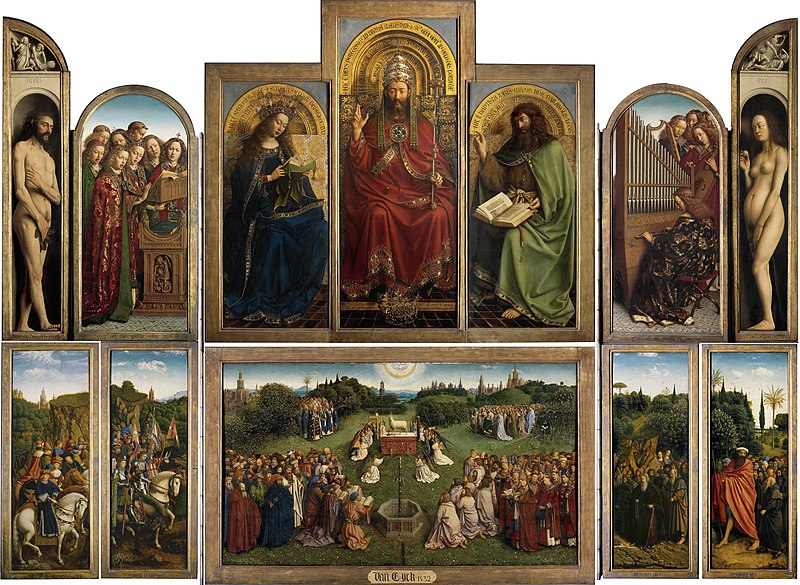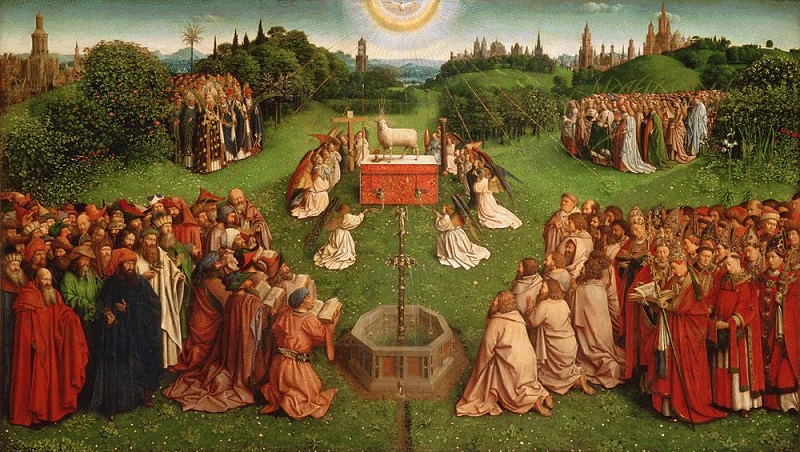We know how treasures are robbed during wartime. War gives the winning team the ultimate freedom to do anything against the lost. Usually, most winners (mis)use this freedom at most and commit as many crimes against the lost, including looting precious materials, gold and other valuable things and setting fire to their heritage and history.
Sometimes, an artwork can tell the story of the human savage’s nature of robbery. The Ghent Altarpiece (1420-32), also known as Adoration of the Mystic Lamb, a painting by Hubert and Jan Van Eyck, is famous for marking the transition from Middle Ages to Renaissance art and is notorious for its the stolen history. This painting faced numerous nuisances encountered from the 15th to 19th century: ruined in a fire, Calvinists tried to burn it in a riot; forged, pillaged, dismembered, and censored; stolen by Napoleon, and chased in the world war period, traded by a renegade cleric, stolen tales are recounted during the second world war and after a while being saved by The Monuments Men, miners and a team of commando double-agents.

The altarpiece has viewed as a masterpiece of European art and one of the world’s treasures, and many European politicians secretly desire to own this masterpiece for their private collections at different times. The Vijd Chapel in St. John the Baptist church commissioned the painting, now titled St. Bavo Cathedral. American Art historian novelist, Noah Charney, writes about the mysterious stolen history of this painting in ‘Stealing the Mystic Lamb: The True Story of the World’s Most Coveted Masterpiece’. ‘It had been the victim of every conceivable transgression that could imperil a work of art. Over five centuries, it had been involved in thirteen attempted and successful crimes and had rarely remained intact in its place of origin for more than a few years, writes Charney.
Why Nazi regime, Hitler and Reichsmarschall Hermann Göring fond of this painting, not only because of the beauty and fame but of this painting symbolising Aryan supremacy and idolised the Artist who created it as an exemplary figure in Teutonic history, according to Charney.
In that book, Charney explains the plan of Hitler’s super museum and the art looting. Stolen works from Nazi-occupied territories all over Europe, 12,000 works in the stolen collection already, including the masterpieces by Michelangelo, Raphael, Vermeer, Rembrandt, Titian, Breughel, Veronese, Dürer, and Leonardo. But, according to Charney, the work that the Nazis prized above all was Jan van Eyck’s Ghent Altarpiece.
It’s a vast and complex artwork, presumably started by Hubert and finished by Jan Van; it is the theory art historian’s account of this. Some historians argue that Hubert designed the prevailing structure, panels were painted by Jan, and in some cases, who painted it, the separation has yet to be established. In many ways, this painting is an icon of Western art, pointing to the change in human representation, and as Erwin Panofsky famously wrote, ‘Van Eyck’s eye functioned “as a microscope and a telescope at the same time’.
‘The fame of the altarpiece comes from its artistic beauty and interest and its importance to art history. This importance was constantly reasserted through the centuries, as one generation after another of artists, writers, and thinkers extolled the virtues of the painting, from Giorgio Vasari to Gotthold Ephraim Lessing to Erwin Panofsky to Albert Camus, writes Charney in his book.
The controversy related to this work is enduring in contemporary art discourse. Art historians argue that ‘Ghent Altarpiece was the last artwork of the Middle Ages, or one might state that this was the first painting of the Renaissance’. This significant work brings humanism into the painted world and brilliantly uses oil painting, effectively establishing Renaissance.
This painting conveys an ordinary visual meaning of Christianity to the devotees and addresses the ‘knowledgeable viewers’; for them, the mystical secrets of Catholicism are embedded.
Art is always under patronage; before modernism, that was a religious patronage system; artists worked for princes, dukes, cardinals, and kings. Artists started working on their ideas in the seventeenth century, and the emerging wealthy ‘middle class began to buy art for home display and enjoyment’. Affluent, middle-class conceive art beyond the definition of religious symbolism, and they look into art from enjoyment and pleasure, which define art beyond direct meaning. This is the time when the value added to ‘Art’ as an economy of the elite class. According to Charney, art theft, parallelly art collections, started after the French Revolution.
The artwork is a complex matter of Artist and creativity. Art is the born product of the Artist and is a myth destroyed by the wealthy- monied people, and that realm is dead after the creation of a painting. The reason why this painting was looted in a different period varies from time to time.
And the Art Thieves’ Award for Most Appealing Work Goes to ‘Ghent Altarpiece’

Krispin Joseph PX, a poet and journalist, completed an MFA in art history and visual studies at the University of Hyderabad.





